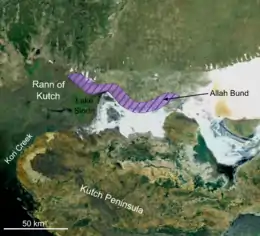Shakoor Lake
Shakoor Lake is a lake, comprising 300 km2, located on the border between the Indian state of Gujarat and the Sindh province on the southern edge of Pakistan. About 90 km2 of the lake comes under Pakistan, whilst the majority of the lake i.e. 210 km2, lies within India. The Indian built Indo-Pak Border Road runs across the Shakoor Lake and it is joined by the Indian GJ SH 45 State Highway just east of the lake, at the Kanjarkot Fort.
| Shakoor Lake | |
|---|---|
 Shakoor Lake | |
| Coordinates | 24°15′28″N 69°04′20″E |
| Surface area | 300 km2 (120 sq mi)[1] |
During the 2010 Pakistan floods, a controversial decision was made by Provincial Minister of Sindh, Zulfiqar Mirza, to release saline water and effluent into Shakoor Lake to alleviate pressure on the Left Bank Outfall Drain (LBOD) in Badin, Pakistan.[2]
Origin

This lake is formed by the emergence of Allah Bund on its southern side by blocking the Nara river (also known as Puran river or Kori river) when a massive earth quake struck the area in 1819. During the river flooding, Shakoor lake surpluses into the Kori Creek through the gaps formed in Allah Bund. Another low level lake called Sindri lake, located at 24°02′11″N 69°05′59″E, is also formed by subsidence to the south of the uplifted Allah Bund during the earthquake. Geographically and environmentally, Lake Shakoor is part of the cross-border Rann of Kutch, a large seasonal salt marsh and a Global 200 Ecoregion.
Environmental concerns
The way water retention and salt extraction has been practised in the Rann of Kutch region, is causing, and has already caused, devastating effects on the local environment; reducing the natural wild life population, drying up and deforesting jungle habitats and mangroves, and threatening the entire regional ecosystem. In Lake Shakoor, salt extraction has been seen as the main culprit in this regard.[3]
Border disputes
The Shakoor Lake area became involved in the century long "Kutch Dispute" in the 1960s, when Pakistani forces entered the area with a tank division and fortified the Kanjar Kot Fort. The Kutch Dispute then became part of the long-running and continuing border disputes between India and Pakistan, but it originated in the 1910s between the Bombay Presidency and the Princely State of Cutch, thus predating the creation of India and Pakistan. The borders in the Kutch Region was finally settled and effectuated on February 19, 1968, when both sides accepted the award of the Indo-Pakistan Western Boundary Case Tribunal designated by the UN secretary general. Sir Creek in the southwest of Great Rann of Kutch is still disputed though.[4]
References
- "LBOD project in Southern Pakistan is a social and ecological disaster - 'People's Tribunals' of 2008 and 2007". South Asia Citizens Watch. 11 November 2008. Retrieved 18 April 2019.
- "LBOD Breach". The Express Tribune. 17 August 2011. Retrieved 18 April 2019.
- "Environmental changes in Coastal Areas of Sindhi". Centre for Science and Environment (CSE). 2 December 2010. Retrieved 2015-12-28.
- "Rann of Kutch 1965". GlobalSecurity.org. Retrieved 28 December 2015.